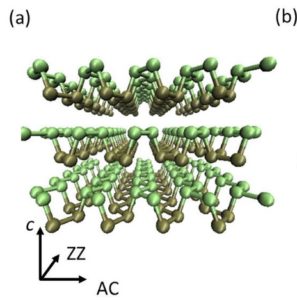Researchers are using XSEDE supercomputing resources in the search for new materials for power-efficient electronics.
 Smaller electronic components offer us more power in our pockets. But thinner and thinner components pose engineering problems. Anisotropic materials—those with properties that vary in direction—hold promise for being unusually versatile. Still, their properties, particularly as they become “two dimensional,” or ultra-thin, are not well understood. Using a combination of calculations on XSEDE-allocated resources and lab experiments, a UCLA-led group showed that an atomistic model can explain and predict the transfer of heat between aluminum and black phosphorous, a highly anisotropic material with possible applications in future devices.
Smaller electronic components offer us more power in our pockets. But thinner and thinner components pose engineering problems. Anisotropic materials—those with properties that vary in direction—hold promise for being unusually versatile. Still, their properties, particularly as they become “two dimensional,” or ultra-thin, are not well understood. Using a combination of calculations on XSEDE-allocated resources and lab experiments, a UCLA-led group showed that an atomistic model can explain and predict the transfer of heat between aluminum and black phosphorous, a highly anisotropic material with possible applications in future devices.
Yongjie Hu, who leads a team of scientists at the UCLA Samueli School of Engineering, wanted to understand heat transfer between aluminum and a prototype 2D material called black phosphorous. This material is special because it is highly anisotropic. In other words, its properties vary depending on which direction they’re measured in its crystals. Such a material could have very different roles in super-miniaturized materials just by placing it in different orientations with other materials.
Thermal management is a critical bottleneck for the advancement of modern electronics, where a major challenge is the poor interfacial thermal transport between materials junctions,” said Yongjie Hu from UCLA. “Reducing the thermal boundary resistance, or TBR, could significantly improve heat dissipation from hot spots and lead to revolutionary advances in high-performance electronics. However, so far, a fundamental understanding of TBR remains elusive and lags far behind that of continuous heat conduction regime. We are glad to make contribution here to better developing TBR-structure relationships through the combination of experiments and atomistic theory.”
Hu and his colleagues took a close look at the black phosphorous-aluminum junction in two ways. They did a series of lab experiments in which they measured the resistance to heat transfer—called thermal boundary resistance, or TBR—when the black phosphorous was oriented in different directions. They also turned to detailed simulation of the materials on the XSEDE-allocated Bridges system at the Pittsburgh Supercomputing Center.
In the lab experiments, black phosphorous showed some remarkable properties. The scientists knew from previous research that the material has a very different chemical structure in different directions. It consists of sheets of the material, with the sheets themselves held together by strong chemical bonds and connected to each other through much weaker forces. Because of the weak interaction between the sheets, heat doesn’t move between them nearly as well as it does within them.
As the material gets thinner, the properties within the black phosphorous crystal become less important to the transfer of heat. But the anisotropy that is no longer important within the crystal still has a strong effect on the junction with aluminum. When the scientists oriented the black phosphorous so the heat had to travel in the direction that crossed the sheets, the TBR was 241 percent and 327 percent as high as it was in the two directions within the sheets. This set a record for measured TBR anisotropy in a material.
For a complicated system, for example with more than 500 atoms … the density functional theory calculations need large memory … With the help of Bridges’ large memory, we were able to apply the theory on these large supercells with several hundreds of atoms, and therefore achieved very high calculation accuracy.”—Yongjie Hu, UCLA
Better, the TBR predictions of the “ab initio” calculations they did on Bridges showed excellent agreement with the lab results. This raised their confidence that they understood why the material was acting this way and how it would perform in future electronic devices. These calculations used both Bridges’ “regular memory” and “large memory” nodes. The scientists needed the latter to handle the massive data of simulating the material’s behavior from first principles, or density functional theory. Bridges’ large memory nodes have 3 terabytes of RAM, almost 200 times as much in a single node as you’d find in a high-end laptop computer.

TBR and material characterization of BP. a) Schematic of the crystal structure of BP. b) Schematic of thermal transport and temperature profile across a material interface. τAB represents the mode-specific transmission of phonons from material A to material B. k and i represent the phonon wave vector and polarization, respectively. An abrupt temperature drop (ΔT) at the material interface indicates a TBR that restricts the heat flux (Q) going across the interface. c) Optical images of BP samples. d) Angle-dependent Raman spectroscopy of BP. e) The intensity plot of three Raman peaks with measurement angle dependence and used to determine the crystal orientations of BP. f) High-resolution transmission electron microscopy image of the interface between aluminum and black phosphorus.
Black phosphorous could be an unusually versatile component in ultra-thin devices. By orienting the material in one direction, engineers can help the device shed heat quickly and avoid over-heating. By orienting in another direction, they can create a junction that maintains heat, which can help researchers develop better thermal isolation or insulation methods. Better, the combination of lab experiments and Bridges simulations made the scientists confident that the material’s performance—and that of other anisotropic materials—will be predictable enough for engineering application. Hu adds that black phosphorus served as a proof-of-concept substance in the current study, but the improved understanding of anisotropic interface energy transport and TBR-structure relationship is generic. The results, then, will be applicable to problems involving different materials and different types of energy transfer. The scientists reported their results in the journal Advanced Materials in June 2019.
Source: Ken Chiacchia, Pittsburgh Supercomputing Center and XSEDE




